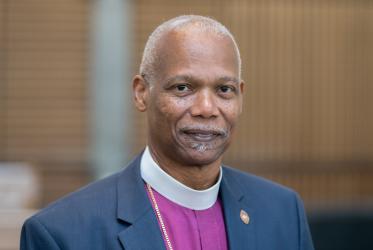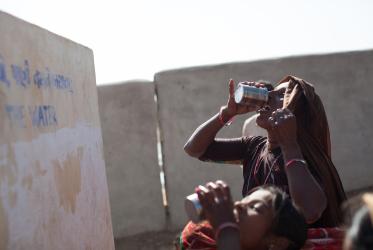Text:
Genesis 21:14-19
REFLECTION
When we think of water, thousands of pictures of our country come to mind. Colombia is considered one of the richest countries in the world when it comes to water reserves; its watersheds are an enormous treasure, rivers that emerge from the high mountains run across a great part of the country. However, it is also important to recognize that the water reserves and the backwaters have been threatened by the economic model, by the mega mining projects, and the urban development projects that the Colombian government is responsible for approving without considering the depletion of these sources of water. In the words of Boff and Hathaway, they suggest that “our world is dominated by a pathological, out-of-control system that, when left to its own urge, threatens to destroy the earth” (36).
Similarly, pictures of water in the biblical Scriptures also come to mind. It is precisely here where the tale of a slave woman, foreigner and concubine, named Hagar, tells us her sufferings and the new life she found from water. In Genesis 21:14-19, we find bread and water as symbols of life alternatives. Hagar, who lives in a patriarchal structure, must suffer a whole system of oppression within which she is given by Sarah to Abraham in order to have his offspring. Hagar faces the hardships of a socio-cultural system that rejects her and that places in her hands only a piece of bread and a skin of water and sends her away to the desert. It is possible that some may have thought of Abraham as kind, but no. If we think carefully, this is only one serving that would not last a long journey through the desert.
It is interesting how the narrative in Genesis tells us of Hagar’s anguish, already in the desert, which for some may be the end of life, but for Ishmael does not mean death; it is rather a space for life. When Hagar no longer has anything to drink, she decides to stop on the way and seek shelter for her son. She sees a bush, places Ishmael under it and walks away so she does not have to see him die. However, in my opinion, I cannot interpret this action as an act of abandonment from Hagar towards her son, but rather of a search by a woman who is alone and who needs to find herself from her place of anguish; this is also the reason why Hagar looks for a place for herself. And it is from there, from that place, that Ishmael’s cry is heard by God. God comes close and initiates an intercultural relationship with Hagar. God looks beyond her Egyptian origin, feels the pain, the anguish, the despair of a woman who cannot find alternatives in the desert.
The narrative reveals a God that takes on a human form, who talks, who is able to ask, “what is going on with you?”; who is able to comfort and to say, “get up” and touch Hagar’s hand. This act of God leads Hagar to see what she could not see before, blinded by the anguish and abandonment caused by a discriminating social system. The narrative says, “that God opened her eyes and she saw a well of water”. “Inside the well, the fountain, life sprouts (…). To God, the waters are like His way of seeing us, of caring for us. As if it were the eye of God, from where He sees” (Schwantes, 16) This gesture leads Hagar to move and get water to give to her son. “In those worlds, the fountains and wells were possibly a woman’s privileged public space. As far as we know of the world at that time, fetching water was a woman’s job (Genesis 24:16). The well was the woman’s world, her culture. Between chapters 16 and 21, that is where Hagar’s tales were told. The storytellers were those carrying water: the young women, the daughters, the woman slaves” (Milton Schwantes, 17). Hagar therefore recognizes herself in her own place, at the well, in the place where she went to fetch water, in the place where life emerges.
Once again, God gives hope through water; He emphasizes the value of water as an element that sustains life. Water allows Hagar and her child to reclaim life and the ability to plan for the present and the future in the desert of Paran.
The tale of Hagar’s suffering due to not having water reminds me of the story of a small village called Pital de Megua, located in the township of the Baranoa municipality, Department of the Atlantic (Northern Coast of Colombia), which has been abandoned by the state. Pital is a rural village where farmers try to make a living from working the land. The issue of water in this community is an old one and the women resemble Hagar in that they are very anxious because they do not have drinking water for their families. According to the community leaders, in Pital water has always been hard to get. One of the alternatives they sought was to dig deep artisanal water wells in their homes to try to draw water from the land for their daily needs. This used to be a traditional, daily woman’s task, however women often went to the well and found that there was no water they could give to their families. This caused anxiety and cries.
In 1936, community leaders built a bigger and deeper artisan well that could provide water to the whole village, however this water did not taste good, it was full of sulfur and salt and it was hard to drink. Local governments would not offer an alternative solution to the people. Much later, in the 1960s, after complaints and protests from the community, the aqueduct arrived. Nonetheless, the issue of the water in Pital remains, since the water that reaches the households is not safe and the quality of the aqueduct’s construction materials oxidize and cause health problems to those drinking the water. Therefore, the women lead a daily struggle with their families and social organizations in order to have drinking water, since they are the ones responsible for providing water for their families and their homes. This is also the reason why, as Hagar sees in her cries, a moment of relief from her oppressive situation, the women and the majority of the community of Pital frequently engage in public protests as a way of pressuring local governments, and demanding that the water reaching their homes be clean. And, therefore, as God gives Hagar, through water, a new home, this community dreams of safe drinking water for their families.
QUESTIONS FOR DISCUSSION:
- Who profits from the water business in each of our local contexts?
- What can we do to keep open water reserves free from contamination and for water to be a source of hope for all people?
- Do you think that in most cases, the burden of securing water for the family disproportionately lies on the women?
ACTIONS:
- Before the magnitude of the water issues, we need not only this small village but the whole country and the entire world to organize retreats on: the ethics of water management, what guarantees a new conscience and a new practice of life regarding water.
- It is important that faith communities lead a new biblical-theological conception about water to break away from the traditional paradigms that taught us that, as Capra says, “nature had to be harassed (…), subjected and forced to serve, enslaved; it had to be “forcefully repressed (…) it had to be tortured to the point of extracting its secrets” (28). This made us think of water as inexhaustible and able to renew itself, which then allowed us to exploit and spend as we pleased.
PRAYER FOR WATER
God Creator of the green mountains and the water that emanates from its entrails,
We come together as a people, in a sole cry as Hagar’s was,
To plead on behalf of all communities that suffer from lack of water.
God Creator of the fields, lakes and rivers,
We come together in a single voice, to ask you to listen to the plight of your people for
Climate justice to be part of governments’ agendas.
God Creator of life, of the streams that run through pastures,
We come together in a chant of hope as when Hagar saw the water well in the desert,
For water to keep being a symbol of home for mankind.
Amen.
REFERENCES:
Capra, F. (1992). El punto crucial: ciencia, sociedad y cultura naciente. Argentina: Editorial Troquel.
The New International Version (NIV) of the Bible
Hathaway, M. y Boff, L. (2014). El tao de la liberación: una ecología de la
Transformación. Madrid: Editorial Trotta.
Revista de Interpretación Latinoamericana –RIBLA (2001). No. 39, Sembrando Esperanzas, Quito – Ecuador. “Milton Schwantes, “Lindas Palabras en Lugares Escondidos”




